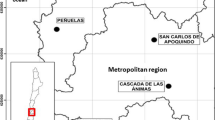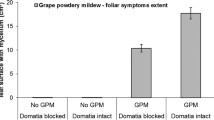Abstract
Predators and parasitoids may contribute to controlling the population sizes of phytophagous insects, and this has been shown to benefit plants. Phytophagous insects may also be killed by other herbivores (intraguild predation), usually larger-sized vertebrates that ingest insects accidentally while feeding on common food sources. We studied the intraguild predation on acorn weevils by ungulates and assessed the consequences for weevil populations. Infested acorns are prematurely abscised and the weevil larvae finish their development inside the acorns after being dropped. Our results show that weevil larvae were killed by ungulates eating the infested acorns on the ground. Ungulates did not discriminate between infested and sound acorns, and the probability of a larva being incidentally eaten was inversely related to acorn availability. Thus, predation risk was enhanced by the premature drop of infested acorns when acorn availability on the ground was low. Predation rates on infested acorns were much higher where ungulates were present, and acorn infestation rates were significantly lower. However, ungulates did not provide the oaks any net benefit, since the reduction of infestation rates was not enough to compensate for the large amounts of sound acorns eaten by ungulates. Seed predation is usually studied as a progressive loss of seeds by pre- and post-dispersal predators, but the interactions between them are usually not considered. We show that intraguild predation on insects by large ungulates had an effect on the structure of the foraging guild, as the proportion of acorns predated by insects decreased; however, replicating the same experimental design in different ecological scenarios would increase the strength of these results. In conclusion, the present study shows the importance of considering the multi-trophic interactions between seed predators in order to have a complete picture of granivory.

Similar content being viewed by others

References
Berryman AA (1996) What causes population cycles of forest Lepidoptera? Trends Ecol Evol 11:28–32
Bonal R (2005) Fitness consequences of the interactions between Quercus ilex and its specialist predispersal seed predator, Curculio elephas. PhD thesis, Universidad Autónoma de Madrid, Madrid
Bonal R, Muñoz A, Díaz M (2007) Satiation of predispersal seed predators: the importance of considering both plant and seed levels. Evol Ecol (in press)
Boucher DH, Sork VL (1979) Early drop of nuts in response to insect infestation. Oikos 33:440–443
Bugalho MN, Milne JA, Racey PA (2001) The foraging ecology of red deer (Cervus elaphus) in a Mediterranean environment: is a larger body size advantageous? J Zool 255:285–289
Coutin R (1960) Estimation de l´importance des populations d´imagos de Balaninus elephas Gyll dans une châtaigneraie cévenole. Rev Zool Agric Appl 59:1–5
Crawley MJ, Pattrasudhi R (1988) Interspecific competition between insect herbivores: asymmetric competition between cinnabar moth and the ragwort seed-head fly. Ecol Entomol 13:243–249
Debouzie D, Heizmann A, Desouhant E, Menu F (1996) Inteference at several temporal and spatial scales between two chestnuts insects. Oecologia 108:151–158
Desouhant E (1998) Selection of fruits for oviposition by the chestnut weevil, Curculio elephas. Entom Exp Appl 86:71–78
Díaz M, Campos P, Pulido FJ (1997) The Spanish dehesa: a diversity in land use and wildlife. In: Pain DJ, Pienkowski MW (eds) Farming and birds in Europe. The Common Agricultural Policy and its implications for bird conservation. Academic Press, London, pp 178–209
Díaz M, Martin P (1998) Habitat selectivity in wintering wood pigeons (Columba palumbus) in holm oak dehesas of central Spain. Gibier Faune Sauvage 15:167–181
Dixon DD, Johnson WC, Adkinson CS (1997) Effects of weevil larvae on acorn use by blue jays. Oecologia 111:201–208
Eikenbary RD, Raney HG (1973) Intratree dispersal of the pecan weevil. Environ Entomol 2:927–930
Fernández Carrillo JL, Fernández Carrillo E, Alonso-Zarazaga MA (2002) Las especies del género Curculio (Coleoptera, Curculionidae) del Parque Nacional de Cabañeros. Comunicación al X Congreso Ibérico de Entomología, Zamora
Fonseca CR (1994) Herbivory and the long-lived leaves of an Amazonian ant-tree. J Ecol 82:833–842
Gómez JM, Gonzalez-Megias A (2002) Asymmetrical interactions between ungulates and phytophagous insects: being different matters. Ecology 83:203–211
Gómez JM (2003) Spatial patterns in long-distance dispersal of Quercus ilex acorns by jays in a heterogeneous landscape. Ecography 26:573–584
Gómez JM, Gonzalez-Megias A (2005) The relative importance of trait-mediated indirect interactions, density-mediated indirect interactions and direct interactions between mammalian and insect herbivores. In: Ohgushi T, Craig T, Price PW (eds) Impact of trait-mediated indirect effects of plants on structure of herbivorous insect communities. Cambridge University Press, Cambridge
Hoballah MEF, Turlings TCJ (2001) Experimental evidence that plants under catterpillar attack may benefit from attracting parasitoids. Evol Ecol Res 3:553–565
Hoballah ME, Kollner TG, Degenhardt J (2004) Costs of induced volatile production in maize. Oikos 105:168–180
Holbrook SJ, Schmitt RJ (2004) Population dynamics of a damselfish: effects of a competitor that also is an indirect mutualist. Ecology 85:979–985
Inouye BD (1999) Estimating competition coefficients: strong competition among three species of frugivorous flies. Oecologia 120:588–594
Janzen DH (1966) Coevolution of mutualism between ants and acacias in Central America. Evolution 20:249–275
Menu F, Debouzie D (1993) Coin-flipping plasticity and prolonged diapause in insects: example of the chestnut weevil Curculio elephas (Coleoptera: Curculionidae). Oecologia 93:367–373
Moon DC, Stiling P (2002) The influence of species identity and herbivore feeding mode on top-down and bottom-up effects in a salt marsh system. Oecologia 133:243–253
Muñoz A (2005) Ecological analyses of the predator and dispersal behaviour of Algerian mice (Mus spretus) and wood mice (Apodemus sylvaticus) foraging on Holm oak (Quercus ilex) acorns. PhD thesis, Universidad Complutense de Madrid, Madrid
Polis GA, Myers CA, Holt RD (1989) The ecology and evolution of intraguild predation. Annu Rev Ecol Syst 20:297–330
Polis GA, Holt RD (1992) Intraguild predation: the dynamics of complex trophics interactions. Trends Ecol Evol 7:151–154
Pulido FJ (1999) Herbivorismo y regeneración en la encina (Quercus ilex. L). PhD thesis, Universidad de Extremadura, Cáceres
Pulido FJ, Díaz M (2005) Regeneration of a Mediterranean oak: a whole-cycle approach. EcoScience 12:92–102
Skalski JR (1987) Selecting a random sample of points in circular field plots. Ecology 68:749
Steele MA, HadjChikh LZ, Hazeltine J (1996) Caching and feeding decisions by Sciurus carolinensis: responses to weevil-infested acorns. J Mammal 77:305–314
Strauss SY, Zangerl AR (2002) Plant–insect interactions in terrestrial ecosystems In: Herrera CM, Pellmyr O (eds) Plant–animal interactions, an evolutionary approach. Blackwell Science, Oxford, pp 77–106
Traveset A, Willson MF, Gaither JC (1995) Avoidance by birds of insect-infested fruits of Vaccinium ovalifolium. Oikos 73:381–386
Van Loon JJA, de Boer JG, Dicke M (2000) Parasitoid–plant mutualism: parasitoid attack of herbivore increases plant reproduction. Entom Exp Appl 97:219–227
Wootton JT (1994) The nature and consequences of indirect effects in ecological communities. Annu Rev Ecol Syst 25:443–466
Yu XD, Zhou HZ, Luo TH (2003) Spatial and temporal variations in insect-infested acorn fall in a Quercus liaotungensis forest in North China. Ecol Res 18:155–164
Acknowledgements
Comments of M. Diaz, C. Smit, J. M. Aparicio and M. T. Monaghan improved previous versions of this manuscript. L. Arroyo, B. A. Nicolau and N. Fermin helped with the fieldwork. J. Jimenez allowed and provided facilities for fieldwork at Cabañeros National Park. This study was supported by the projects REN2003-07048/GLO of the Ministerio de Ciencia y Tecnología, PAC-02-008 of the Junta de Comunidades de Castilla-La Mancha and 096/2002 of the Ministerio de Medio Ambiente. R. B. and A. M. were supported by fellowships from La Junta de Comunidades de Castilla La Mancha.
Author information
Authors and Affiliations
Corresponding author
Additional information
Communicated by Diethart Matthies.
Rights and permissions
About this article
Cite this article
Bonal, R., Muñoz, A. Multi-trophic effects of ungulate intraguild predation on acorn weevils. Oecologia 152, 533–540 (2007). https://doi.org/10.1007/s00442-007-0672-8
Received:
Accepted:
Published:
Issue Date:
DOI: https://doi.org/10.1007/s00442-007-0672-8



